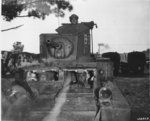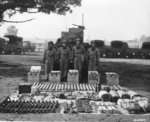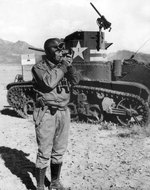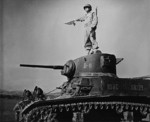M3 Stuart
| Country | United States |
| Primary Role | Light Tank |
Contributor: C. Peter Chen
ww2dbaseThe United States Army began operating the new Light Tank M3 vehicles in Mar 1941. Before the Americans took them to combat, however, as the United States would not enter WW2 until the end of that year, they exported to British and Commonwealth forces that were already involved in war with Germany and Italy. The British nicknamed these American light tanks General Stuart, after the American Civil War general; 170 British General Stuart light tanks took part in Operation Crusader in North Africa. British tank crews complained of the ineffective 37-millimeter guns and the short range, although they were liked for the high speed and mechanical reliability. After mid-1942, the British largely kept them out of direct combat missions, using them as reconnaissance, transport, and command vehicles instead. The Russians also received M3 tanks; though they were put in use, the Russians generally disliked these light tanks, citing logistical complications with fuel (use of high octane fuel rather than the more typical diesel usage among Russian tanks), engine sensitivity of impurities in fuel, and use of narrow tracks (which tend to sink into snow more often than tanks with wider tracks).
ww2dbaseThe first American M3 light tanks to see combat were those deployed to the Philippine Islands, which faced the Japanese invasion of Dec 1941. They were the main American tank strength in late 1942 when the American arrived in North Africa, but by 1943 many of the front line combat units had their M3 light tanks replaced with heavier tanks such as the M4 Sherman medium tanks. In the latter stages of WW2, M3 light tanks operated largely as reconnaissance vehicles only in Europe as they were outclassed by the typical German armor, but in the war against Japan they remained useful as combat vehicles.
ww2dbaseProduction of the M3 light tanks lasted from Mar 1941 through Oct 1943. To alleviate the demand on the aircraft industry, beginning in Oct 1943 the M3 design saw its use of aircraft radial engines change to automobile engines made by Cadillac. This new variant, designed M5, continued to be built through 1944. Over 25,000 vehicles were built during this time. M3 and M5 light tanks remained in service in the United States through the post-WW2 period, and were sold to countries friendly to the United States, such as France, Nationalist China, and Tito's partisan forces in Yugoslavia.
ww2dbaseSource: Wikipedia.
Last Major Revision: Oct 2009
SPECIFICATIONS
M3
| Machinery | One Continental W-670-9A 7-cylinder air-cooled radial engine rated at 250hp |
| Suspension | Vertical volute spring |
| Armament | 1x37mm M6 gun (174 rounds), 3x7.62mm Browning M1919A4 machine guns |
| Armor | 13-51mm |
| Crew | 4 |
| Length | 4.50 m |
| Width | 2.46 m |
| Height | 2.30 m |
| Weight | 14.7 t |
| Speed | 30 km/h off-road; 58 km/h on-road |
| Range | 120 km |
Photographs
 |  |  |  |
Videos
 |
Did you enjoy this article or find this article helpful? If so, please consider supporting us on Patreon. Even $1 per month will go a long way! Thank you. Share this article with your friends: Stay updated with WW2DB: |
Visitor Submitted Comments
15 Feb 2014 08:21:32 PM
I am respectfully looking for a Stuart Tank, to be displayed at the town where it is made. If anyone knows where I can aquire one, please let me know. Thank You very much!
Sincerely,
Lee Howard (U.S. Coast Guard Ret.)
28 Sep 2015 12:56:20 PM
add more iformation
18 Mar 2023 03:25:52 PM
My dad was the driver of the M5A1 variant of the Stuart during WWII in Europe. It was a cleaner version of the M3 with the driver and bow gunners in protected covers where the M3 had a flat plate facing the enemy. Perhaps the best part of the M5A1 was the change in engines. The M3 used a radial aircraft engine whereas the M5A1 used TWO Cadillac car V-8 engines and an, essentially, automatic transmission. There was also the ability to disconnect one engine from the drivetrain in case it was damaged, so that the tank would still get you back to your base. This did not require any of the crew to go outside the vehicle to accomplish this.
All visitor submitted comments are opinions of those making the submissions and do not reflect views of WW2DB.
- » Wreck of USS Edsall Found (14 Nov 2024)
- » Autumn 2024 Fundraiser (7 Nov 2024)
- » Nobel Peace Prize for the Atomic Bomb Survivors Organization (11 Oct 2024)
- » Wreck of USS Stewart/DD-224 Found (2 Oct 2024)
- » See all news
- » 1,150 biographies
- » 337 events
- » 43,917 timeline entries
- » 1,241 ships
- » 350 aircraft models
- » 207 vehicle models
- » 373 weapon models
- » 123 historical documents
- » 260 facilities
- » 470 book reviews
- » 28,537 photos
- » 432 maps
General Douglas MacArthur at Leyte, 17 Oct 1944
Please consider supporting us on Patreon. Even $1 a month will go a long way. Thank you!
Or, please support us by purchasing some WW2DB merchandise at TeeSpring, Thank you!
5 Jul 2009 04:47:09 AM
in British service the M3 was officially called the 'General Stuart' (named after
the famed American cavalry commander of the American Civil War) and unofficially nicknamed the 'Honey' - reputedly
because the first unit to be issued with them threw them around to test them and, when asked what they were like, one
driver replied 'It's a honey!'